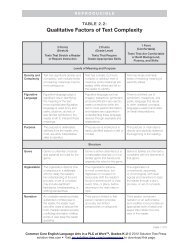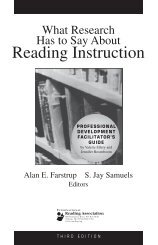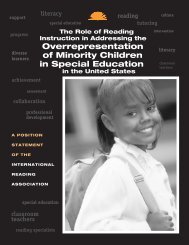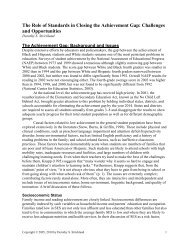Global Education Digest 2012 - International Reading Association
Global Education Digest 2012 - International Reading Association
Global Education Digest 2012 - International Reading Association
Create successful ePaper yourself
Turn your PDF publications into a flip-book with our unique Google optimized e-Paper software.
SECTION 5 / The costs of school failure<br />
High repetition and dropout rates are also associated<br />
with inadequate levels of basic learning achievement<br />
in reading and mathematics. Indeed, results from<br />
SACMEQ III in Southern and Eastern Africa showed<br />
that most countries with poor pupil performance<br />
in reading and mathematics (e.g. Lesotho, Malawi,<br />
Uganda and Zambia) shared the same characteristics<br />
with regard to repetition and early school leaving<br />
(Hungi, 2011). This is also true for low-performing<br />
primary education systems in Central Africa (PASEC,<br />
2010), namely Chad and the Congo. In Latin America<br />
and the Caribbean (LLECE, 2006), low levels of<br />
pupil performance at the primary level were found in<br />
Guatemala and Nicaragua – which have high rates of<br />
grade repetition and early school leaving. At the same<br />
time, these large-scale learning achievement studies<br />
showed that countries with high levels of pupil<br />
performance (for example, Botswana, Costa Rica,<br />
Mauritius and Tanzania) also had more moderate<br />
repetition and dropout rates.<br />
A wide range of different factors can influence levels<br />
of student learning and, consequently, lead to grade<br />
repetition or early school leaving. Which factors<br />
are most relevant and how they interact with other<br />
factors tend to vary by context – between countries<br />
or within population groups (urban/rural, rich/poor) in<br />
a single country.<br />
Previous sections of this report have demonstrated<br />
the importance of student, family and school/<br />
classroom factors for grade repetition and early<br />
school leaving. For example, high rates of repetition<br />
and early school leaving have been associated with:<br />
pupil’s age, gender, motivation, household income,<br />
child labour, command of the instruction language,<br />
educational attainment/illiteracy of parents, urban/<br />
rural location, as well as the educational resources of<br />
the school, instruction conditions, teaching quality and<br />
non-standard assessment of student performance.<br />
It is important to note that these are just some of the<br />
determining factors related to the education system<br />
and family background of the pupils.<br />
From a gender perspective, UIS data show that,<br />
on average, boys are more likely to repeat a grade<br />
in primary education than girls. On the other hand,<br />
girls – typically from low-income households or rural<br />
areas in sub-Sahara Africa, for example – are slightly<br />
more likely to leave school early mainly due to their<br />
responsibilities for the care of younger children, the<br />
gender division of labour in the household economy<br />
or early marriage (Ndaruhutse, 2008). In such cases,<br />
high repetition rates would not explain early school<br />
leaving, nor would learning achievement or schoolrelated<br />
factors. Consequently, measures to enhance<br />
learning in this context may not directly address the<br />
causes of early school leaving.<br />
5.2 GRADE REPETITION AND EARLY<br />
SCHOOL LEAVING ARE COSTLY, BUT TO<br />
WHAT EXTENT?<br />
A number of studies have considered grade<br />
repetition and early school leaving from the<br />
perspective of inefficiencies in the use of resources<br />
(UNESCO/IBE, 1971; UNESCO, 1976, 1980, 1998,<br />
2005). Every pupil who leaves school without<br />
completing the full course of compulsory education<br />
or achieving the learning objectives (e.g. foundation<br />
skills in reading, writing and numeracy) represents<br />
lost investments in addition to lost opportunities<br />
at the level of the individual and society. A pupil<br />
who repeats a grade consumes an additional year<br />
of educational resources, potentially limiting the<br />
capacity of the education system, increasing class<br />
size and the cost per graduate. Yet, in certain<br />
contexts, the pedagogical effects of repetition can<br />
increase the repeater’s learning and labour market<br />
productivity.<br />
There are two broad approaches for estimating the<br />
costs of repetition and/or early school leaving. One<br />
focuses on the direct costs and the other takes<br />
into account indirect costs. Direct costs reflect how<br />
much resources are used in education systems<br />
and, thus, are typically based on per-student or<br />
per-graduate costs. The most basic approach is<br />
simply to multiply the number of repeaters by perstudent<br />
cost – though this can overstate the actual<br />
resources required to accommodate repeaters<br />
in the education system. Based on the cost per<br />
54

















